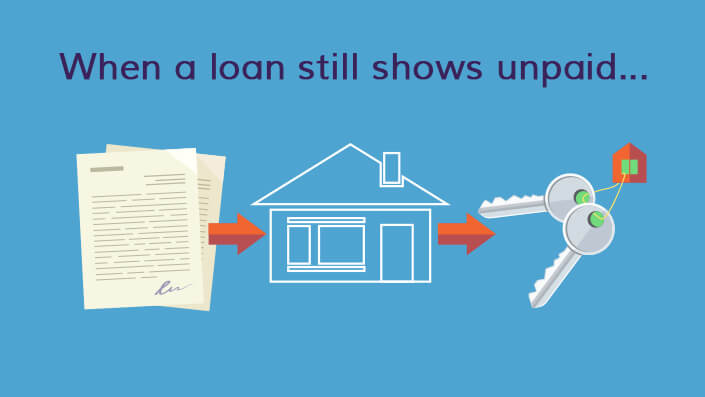
That loan still shows unpaid? What happened? Who dropped the ball? How do I get it resolved?
Every once in a while, and more often than we like, an Escrow Officer will review a preliminary title report and see an old loan that still showed as being unpaid.
What happened?
The explanation is simple: when you get a loan that is using the property as collateral/security, a mortgage document (called a Deed of Trust in California) is recorded on it. When the loan is paid off, the Lender is supposed to record a statement that the loan was paid on the property. This is a “release” (called a Reconveyance form in California). So when the Reconveyance is recorded with the correct information on it it releases the Deed of Trust obligation that was recorded earlier.
Who dropped the ball?
Do all Lenders remember to issue the Reconveyance after the loan is paid in full? Usually, the institutional Lenders follow the process and they do. However, sometimes they will automatically send the document to the County Recorder directly for recording and other times they will forward the document to the Borrower and ask the Borrower to send it to the County by themselves. Not a good idea because 90% of the Borrowers do not follow the instructions and end up just putting the letter and document aside.
If it is a private Lender, chances are that neither the Lender nor the Borrower will remember that once the loan is paid off, the process does not stop there; that documents have to be provided to show “paid in full”. And so the problem arises.
How do I get it resolved?
Solving the problem should be easy: have the Lender sign and notarize the Reconveyance and record it. But life is never simple. Here are a couple of scenarios that can (and do) happen through the years:
1. The original Lender was bought out by another Lender and the new Lender may not have the old documents to prove that the loan was paid off so they have to go back and research. Remember when Glendale Federal Savings was bought out by Home Savings which was bought out by Washington Mutual….
2. The Lender cannot be located to provide release signatures. Maybe he/it no longer exists, moved away, or passed away. This happens a lot on loans that are private individual Lenders, for instance, that Seller who gave you a loan to buy his property 30 years ago….
What do you do? Where do you start? Just a small reminder that although the Escrow Officer can help in certain limited ways by giving you ideas on where to look, you will need to take the initiative and be proactive right from the start.
1. Go through your old paperwork and try to locate anything that concerns this particular loan. Sometimes luck is on your side and you find a letter sent by the Lender with the actual original Reconveyance document tucked inside but never recorded. Hallelujah!
2. If it is an institutional Lender, contact them (or their successor in interest) with any proof that you might have found, whether it is a letter that acknowledges final payment or a cancelled check. Talk to their Payoff Department and ask them for a phone number to connect with their Reconveyance Department which is usually an internal department that does not communicate directly with clients.
3. If it is a private Lender then things get a little tough and some detective work will need to be done. Start with the last known address of the person and go from there. If he is no longer there, ask the Escrow or Title Company to run the name under the General Index in the county of the property and surrounding counties. Maybe he bought another home in another city? Google the name, maybe something will come up
4. If the loan is over 30 years old, ask the Escrow and Title whether they would be willing to insure the property without showing this lien. This does not clean the ownership of the property for the future and is only a stop gap measure for this one-time transaction. The old lien under your name would show up again and again in future transactions.
5. Purchasing a Bond would be the last avenue. The Bond required is usually 2 times the face value of the original loan. The premium amount is between 2% – 5%, depending on your credit score, financial strength and what type of proof of full payment you have. The less the risk liability to the bonding company, the less the premium cost. As an example, if you had an old loan for $30,000, then you will need a bond for $60,000 and the cost would be anywhere between $1,200 and $3,000. Once the Bond is purchased it will be recorded in lieu of the Reconveyance that was lost or never issued.
Summary
When a transaction is opened and the preliminary title report ordered and reviewed, it is important that the Escrow Officer contact the client about all the liens found on the report especially if the lien dates are old and/or for a small amount. Time is of the essence if there is a transaction deadline to meet. No matter if it is an institutional Lender or a private one, the client must be proactive and start looking for proof of payment and start tracing down the whereabouts of the Lender.
Do you have any questions on any escrow or real estate related issues? Ask us! We have answers for you!


Juliana Tu, CSEO, CEO, CBSS, CEI, SASIP
Escrow Manager

Good news! “The Art of Escrow” is out! Look for it on www.amazon.com!

The Art of Escrow:
The Fight For Your American Dream and the Pursuit of Homeownership
Available now at Amazon.com
- Threats to Escrow – Part 5 – Document Fraud! - May 19, 2023
- When the Loan Got Sold and You Just Closed Escrow - April 6, 2020
- Mechanics Lien - October 7, 2019
- Are You a Foreigner and Need to Know About U.S. FIRPTA Withholding Laws? - February 20, 2019
- When the FIRPTA
Withholding Goes Wrong - February 20, 2019
Join Our FREE Viva Escrow Forums
